The Bag-in-Bottle Market is estimated to be valued at USD 7.2 billion in 2025 and is projected to reach USD 10.1 billion by 2035, registering a compound annual growth rate (CAGR) of 3.4% over the forecast period.
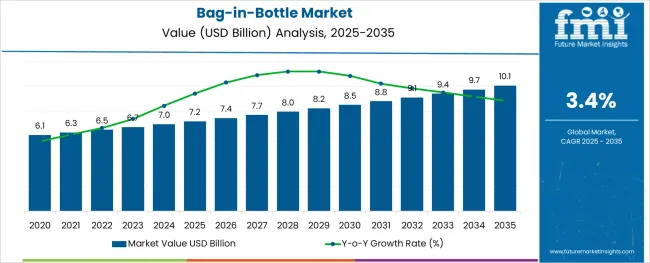
The bag-in bottle market is experiencing steady expansion as industries across food, pharmaceuticals, and cosmetics prioritize efficient, contamination-free, and sustainable liquid dispensing systems. The format offers distinct advantages in terms of precise dosing, oxygen barrier protection, and product preservation, making it ideal for high-sensitivity liquid applications. Increasing demand for hygienic, user friendly packaging particularly in healthcare and cosmetic formulations is accelerating the adoption of bag-in-bottle systems.
Brands are increasingly focusing on packaging formats that extend shelf life while reducing waste and enhancing product integrity. Technological advancements in blow molding and barrier film integration have significantly improved structural reliability and filling efficiency.
Sustainability regulations targeting overpackaging and cross contamination are also influencing design innovations within this segment. With strong alignment to evolving consumer preferences and industrial hygiene standards, the bag in bottle market is expected to remain resilient, presenting opportunities for material innovation, dosage control mechanisms, and cross-industry deployment.
The market is segmented by Volumetric Capacity, Application, and End Use and region. By Volumetric Capacity, the market is divided into Up to 100ml, 100 to 150ml, 150 to 400ml, 400 to 750ml, and Above 750ml. In terms of Application, the market is classified into Liquid products and Semi-solid products. Based on End Use, the market is segmented into Cosmetics & Personal care, Oral care, Skin care, Depilatories, Fragrance, Others, Homecare, and Healthcare. Regionally, the market is classified into North America, Latin America, Western Europe, Eastern Europe, Balkan & Baltic Countries, Russia & Belarus, Central Asia, East Asia, South Asia & Pacific, and the Middle East & Africa.
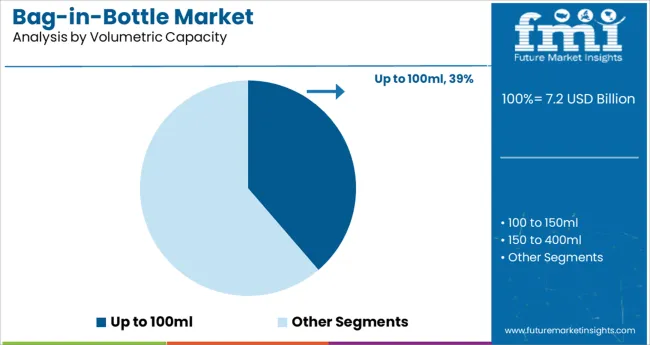
The up to 100ml capacity format is projected to account for 38.70% of market revenue by 2025, emerging as the leading sub-segment under volumetric capacity. This dominance is driven by the rising need for compact, single-dose, and travel-friendly packaging solutions, particularly in the personal care, pharmaceutical, and clinical nutrition sectors.
The smaller capacity format has proven ideal for maintaining product hygiene, preventing contamination, and ensuring accurate dosing. It has also been preferred for sample-size formats and high-value liquid contents where precision and shelf life integrity are essential.
Furthermore, its compatibility with medical-grade resins and advanced dispensing closures supports its growing adoption. The ability to reduce waste, lower shipping costs, and meet stringent health and safety regulations has reinforced the segment’s appeal, positioning it as the most efficient and cost effective capacity format within the bag-in bottle ecosystem.
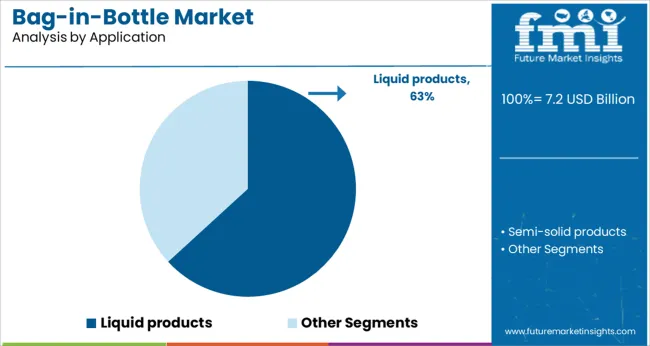
It is noted that the liquid products segment accounts for 63.20% of market share, marking it as the dominant application category in the bag-in bottle market. This segment's leadership is attributed to the growing demand for controlled dispensing and extended preservation of liquids across medical, cosmetic, and food sectors. The bag in bottle structure offers an airless environment that minimizes oxidation and microbial exposure, ensuring product stability and consistent flow.
This makes it especially suitable for emulsions, serums, syrups, and other sensitive liquid formulations. Adoption has been accelerated by brand initiatives focused on reducing preservatives while maintaining shelf life and user experience.
Additionally, the format’s recyclability and compatibility with lightweight dispenser mechanisms align with evolving regulatory standards and sustainability goals. As industries continue to shift toward cleaner, safer, and more efficient packaging systems, the liquid product segment has firmly established itself as the core growth driver of the bag-in-bottle market.
The end-user preference has been influenced by the benefits of bag-in-bottle packaging which includes high barrier packaging of aluminum foil or other high barrier plastics, prevention from contamination by atmospheric oxygen or air, continuous pressure in dispensing the primary product without addition of pressurized gases, low investment in the production of bottle for bag-in-bottle and much more.
The bag-in-bottle packaging is a development introduced for airless dispensing which reduces the four-part production process and manual assembly to single part production packaging system. This has resulted in 60% of the saving in energy and investment as compared to the production of conventional four-part airless packaging.
Also, has driven the bag-in-bottle market at the suppliers' end. Despite significant investment saving possibilities with the bag-in-bottle packaging, the bag-in-bottle market is expected to witness sluggish growth due to the requirement of investment for replacing the conventional airless packaging production line with the bag-in-bottle production line.
Also, the end consumers of the primary products in airless packaging do not find much difference in the packaging, and thus, the introduction of bag-in-bottle packaging do not create much impact on the packaging manufacturers to discard the conventional airless packaging production line. This is expected to restrain the growth of the global bag-in-bottle market.
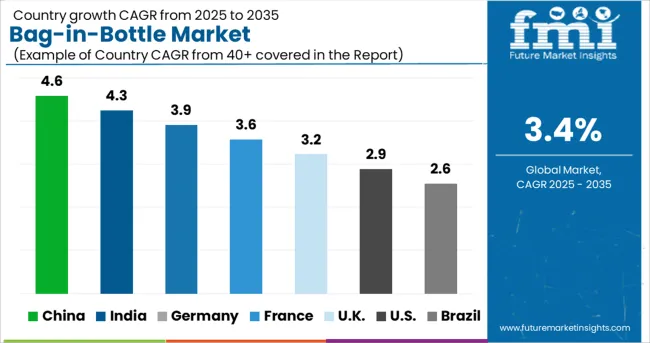
North America market is expected to hold the leading position in the bag-in-bottle market. The tendency of Asia Pacific market to adopt the technological changes is weaker as compared to North America market.
Western Europe is expected to grow at a high pace as compared to North America due to the vast availability of advanced production technology for the manufacturing of packaging and significant presence of large packaging companies in the region. Growing production of cosmetic products in the Asia Pacific and Latin America regions are expected to drive the regional bag-in-bottle market.
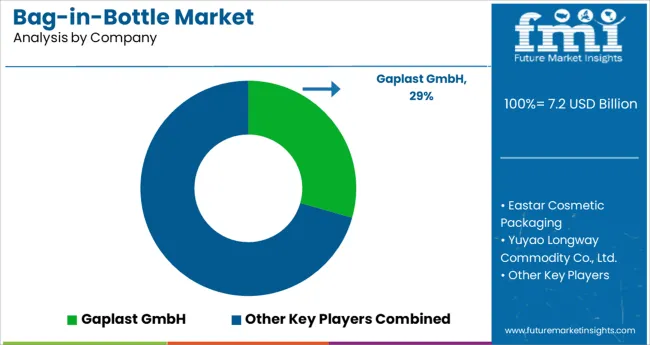
Due to the requirement of high initial investment for establishing a production line for bag-in-bottle and low impact observed on the consumers by the change in the type of airless packaging has led to a very limited number of market players in the global bag-in-bottle market.
Examples of some of the market players in the bag-in-bottle market include Gaplast GmbH, Eastar Cosmetic Packaging, Yuyao Longway Commodity Co., Ltd., RPC Group, AptarGroup, Inc., and AFA Dispensing Group BV.
The report is a compilation of first-hand information, qualitative and quantitative assessment by industry analysts, inputs from industry experts and industry participants across the value chain. The report provides in-depth analysis of parent market trends, macroeconomic indicators and governing factors along with market attractiveness as per segments. The report also maps the qualitative impact of various market factors on market segments and geographies.
The global bag-in-bottle market is estimated to be valued at USD 7.2 billion in 2025.
It is projected to reach USD 10.1 billion by 2035.
The market is expected to grow at a 3.4% CAGR between 2025 and 2035.
The key product types are up to 100ml, 100 to 150ml, 150 to 400ml, 400 to 750ml and above 750ml.
liquid products segment is expected to dominate with a 63.2% industry share in 2025.






Our Research Products

The "Full Research Suite" delivers actionable market intel, deep dives on markets or technologies, so clients act faster, cut risk, and unlock growth.

The Leaderboard benchmarks and ranks top vendors, classifying them as Established Leaders, Leading Challengers, or Disruptors & Challengers.

Locates where complements amplify value and substitutes erode it, forecasting net impact by horizon

We deliver granular, decision-grade intel: market sizing, 5-year forecasts, pricing, adoption, usage, revenue, and operational KPIs—plus competitor tracking, regulation, and value chains—across 60 countries broadly.

Spot the shifts before they hit your P&L. We track inflection points, adoption curves, pricing moves, and ecosystem plays to show where demand is heading, why it is changing, and what to do next across high-growth markets and disruptive tech

Real-time reads of user behavior. We track shifting priorities, perceptions of today’s and next-gen services, and provider experience, then pace how fast tech moves from trial to adoption, blending buyer, consumer, and channel inputs with social signals (#WhySwitch, #UX).

Partner with our analyst team to build a custom report designed around your business priorities. From analysing market trends to assessing competitors or crafting bespoke datasets, we tailor insights to your needs.
Supplier Intelligence
Discovery & Profiling
Capacity & Footprint
Performance & Risk
Compliance & Governance
Commercial Readiness
Who Supplies Whom
Scorecards & Shortlists
Playbooks & Docs
Category Intelligence
Definition & Scope
Demand & Use Cases
Cost Drivers
Market Structure
Supply Chain Map
Trade & Policy
Operating Norms
Deliverables
Buyer Intelligence
Account Basics
Spend & Scope
Procurement Model
Vendor Requirements
Terms & Policies
Entry Strategy
Pain Points & Triggers
Outputs
Pricing Analysis
Benchmarks
Trends
Should-Cost
Indexation
Landed Cost
Commercial Terms
Deliverables
Brand Analysis
Positioning & Value Prop
Share & Presence
Customer Evidence
Go-to-Market
Digital & Reputation
Compliance & Trust
KPIs & Gaps
Outputs
Full Research Suite comprises of:
Market outlook & trends analysis
Interviews & case studies
Strategic recommendations
Vendor profiles & capabilities analysis
5-year forecasts
8 regions and 60+ country-level data splits
Market segment data splits
12 months of continuous data updates
DELIVERED AS:
PDF EXCEL ONLINE

Thank you!
You will receive an email from our Business Development Manager. Please be sure to check your SPAM/JUNK folder too.
Chat With
MaRIA